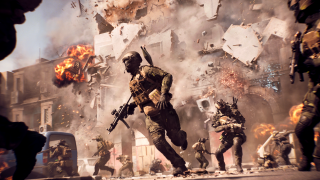Breaking new ground: How Battlefield 6 reimagines destruction
Inside the collaboration between Battlefield Studios and Frostbite that pushed Battlefield 6’s destruction to new heights.
November 10, 2025

When players think of Battlefield, there’s likely one feature that first comes to mind: destruction. The ability to manipulate the in-game world by destroying objects and structures to create tactical advantages is a defining feature of the Battlefield franchise. It’s the unpredictable, awe-inspiring chaos that turns buildings into cover to avoid enemy fire and alters the flow of combat in real time. In Battlefield 6, destruction technology has been taken further than ever before, both technically and creatively.
Behind the scenes, teams across EA collaborated to deliver the most advanced destruction system in the franchise’s history. The result is not just spectacle, but a carefully engineered balance of fidelity, performance, and tactical gameplay. The destruction technology that players across the world are experiencing today reflects years of co-development between the Frostbite team, who are responsible for EA’s state-of-the-art, multi-platform Frostbite game engine, and Battlefield Studios, the development collective formed by Criterion, DICE, Motive, and Ripple Effect.

Building Battlefield’s signature destruction, together
“Ever since Battlefield 2042, the destruction and Frostbite physics teams have had a very close collaborative relationship,” explains Rickard Antroia, Principal Game Designer, DICE. “On Battlefield 6, we essentially looked at who had the best expertise for the task, regardless of where the work needed to happen. That’s the benefit of having an in-house engine and an organization that believes in collaboration and technological advancement.”
That collaboration went both ways. The Frostbite team worked directly alongside Battlefield developers to improve the engine itself, ensuring every explosion, collapsing structure, and piece of cascading debris felt authentic and ran smoothly across all platforms.
“One of the advantages of an internal engine like Frostbite is that we can work really closely with the game teams,” adds Talan Le Geyt, Senior Software Engineer, Frostbite. “We talk a lot so that we, on the Frostbite team, clearly understand Battlefield’s gameplay vision, and Battlefield knows how to get the best out of Frostbite. A lot of the value in that relationship comes from smaller, targeted improvements we made in direct response to feedback.”
Those improvements added up: from new debugging tools that sped up iteration to editor enhancements that streamlined how developers tweak destructible materials, the partnership produced a workflow as dynamic as the technology itself.
Destruction, refined
From the start, the Battlefield team set an ambitious goal: destruction should be both systemic and controlled. The result is a technical system that allows for varied environments that tell a story without devolving into chaos.
“We wanted the players to create a war-torn battlefield, not a moon landscape,” jokes Antroia. “We wanted the result of destruction to stay, creating interesting ruins and level-designed debris piles that reshape the player space.”
This approach required technical breakthroughs. The team revisited the physics fidelity of every system, from debris behavior and terrain deformation to vehicle behaviors. “We let players and assets in the world affect the destruction systems as chaos agents,” Antroia continues. “That’s why we worked on soldier impulse damage, ragdoll impulse, and vehicle dynamics that are much more integrated in the world’s ecosystem, with crashes and destruction remaining persistent. All of these features add to the authenticity.”
Prioritized Destruction Networking, before (left) and after (right)
Innovating from the ground up
The Frostbite engine evolved alongside Battlefield 6, introducing new systems that made destruction more flexible and realistic.
“A major focus for Battlefield 6 was making our part-based destruction and debris spawning systems more extensible,” says Le Geyt. “That allowed the Battlefield team to integrate destruction with other gameplay systems, including things like damage to players beneath destroyed buildings, or debris that falls away more realistically.”
“With Frostbite reworking the health transition system, it allowed game teams to customize what happens in health transitions, like using custom-built processes to alter a state, modify gameplay, or spawn new assets,” notes Johan Leijon, Technical Lead, DICE. “That flexibility has been very important.”
Frostbite and Battlefield Studios teams also overhauled how destruction events are networked. By optimizing bandwidth and prioritization, the teams ensured that even massive 64-player matches packed with simultaneous explosions remain synchronized and responsive for all players.
“Because we’ve reached a much higher fidelity in our destructible environments, we had to work on network improvements like prioritization and culling of part destruction and debris spawning,” explains Leijon. “All of this work enables everything to feel smooth and connected.”
Meanwhile, the Battlefield Studios teams developed runtime features that blurred the lines between visual spectacle and gameplay impact.
"We developed seam and surface emitters that listened to debris activation and explosion shockwaves, using the right VFX based on the visual material of the object," adds Antroia. "The same parameters were also used for our audio systems, to ensure consistency." In other words, the team created a single source for the engine to speak to all of the asset systems.
The culmination of this work is destruction that looks, sounds, and feels alive, and responds dynamically to player action.

A world that reacts to you
From the tiniest splinter to a bridge’s collapse, Battlefield 6’s destruction is more than visual drama; it’s the beating heart of the experience. Every explosion is calculated. Every fragment has a purpose.
As Antroia reflects, “The sum of all parts is what I’m most excited for players to experience. The structure that’s there but that you may not notice at first, and how much you can affect it with opportunistic gameplay.”
Check out other amazing EA stories on ea.com/news.

